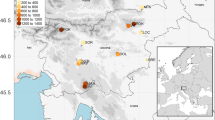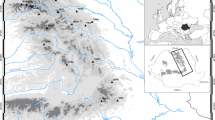Abstract
A widely accepted standpoint contends that plant growth near the cold edge of the species range, such as treelines, does not depend on the annual temperature seasonality (i.e. difference between maximum and minimum temperature values) but rather on the warmth of summer season. In contrast to this expectation, we show that the growth of treeline Norway spruce (Picea abies) is well explained by temperature seasonality as a single climatic determinant. To do so, the tree-ring data of spruce trees growing on alpine treeline in Lapland was compared with long climate records. Biennial time-series of temperature seasonality capture both the decadal and abrupt growth fluctuations with a correlation coefficient of r = 0.601. We also show that the archetypal association between summer temperature and treeline tree growth may in fact be by far a more complex relationship than previously thought. Spruce growth appears responsive to late- June (r = 0.494) and mid-July (r = 0.310) temperatures but unresponsive to temperatures during the early July, that is, during the grand period of the tracheid formation. Climatic warming may enhance the treeline spruce growth unless the warming is concentrated on unresponsive interval in the midst of the growing season. Water relations did not play significant role as agents of P. abies growth.
Similar content being viewed by others
References
Andreassen K, Solberg S, Tveito OE, Lystad SL (2006) Regional differences in climatic responses of Norway spruce (Picea abies L. Karst.) growth in Norway. Forest Ecology and Management 222: 211–221. DOI: 10.1016/j.foreco.2005.10.029
Biondi F (1997) Evolutionary and moving response functions in dendroclimatology. Dendrochronologia 15: 139–150.
Biondi F, Waikul K (2004) DENDROCLIM2002: A C++ program for statistical calibration of climate signals in treering chronologies. Computers & Geosciences 30: 303–311. DOI: 10.1016/j.cageo.2003.11.004
Box GEP, Jenkins GM (1970) Time series analysis: forecasting and control. San Francisco: Holden-Day. p 553.
Briffa K, Jones PD (1990) Basic chronology statistics and assessment. In: Cook ER, Kairiukstis LA (eds.), Methods of dendrochronology: applications in the environmental sciences. Dordrecht: Kluwer Academic Publishers. pp 137–152
Briffa KR, Jones PD, Bartholin TS, et al. (1992) Fennoscandian summers from AD 500: temperature changes on short and long timescales. Climate Dynamics 7: 111–119. DOI: 10.1007/bf00211153
Briffa KR, Jones PD, Schweingruber FH, et al. (1996) Tree-ring variables as proxy-climate indicators: problems with lowfrequency signals. In: Jones PD, Bradley RS, Jouzel J (eds.), Climate Variations and Forcings Mechanisms of the Last 2000 Years. Berlin: Springer-Verlag. pp 9–41. DOI: 10.1007/978-3-642-61113-1_2
Büntgen U, Frank DC, Schmidhalter M, et al. (2006) Growth/climate response shift in a long subalpine spruce chronology. Trees 20: 99–110. DOI: 10.1007/s00468-005-0017-3
Cook ER (1985) A time-series analysis approach to tree-ring standardization. PhD thesis, University of Arizona, Tucson.
Cook ER, Peters K (1981) The smoothing spline: a new approach to standardizing forest interior tree-ring width series for dendroclimatic studies. Tree-Ring Bulletin 41: 45–53.
Cook E, Briffa K, Shiyatov S, Mazepa V (1990a) Tree-Ring standardization and growth-trend estimation. In: Cook ER, Kairiukstis LA (eds.), Methods of dendrochronology: applications in the environmental sciences. Dordrecht: Kluwer Academic Publishers. pp 104–123.
Cook E, Shiyatov S, Mazepa V (1990b) Estimation of the mean chronology. In: Cook ER, Kairiukstis LA (eds.), Methods of dendrochronology: applications in the environmental sciences. Dordrecht, Kluwer Academic Publishers. pp 123–132.
Crawford RMM, Jeffree CE (2007) Northern climates and woody plant distribution. In: Ørbæk JB, Kallenborn R, Tombre I, et al. (eds.), Arctic Alpine ecosystems and people in a changing environment. Berlin, Heidelberg: Springer-Verlag. pp 85–104. DOI: 10.1007/978-3-540-48514-8_6
D’Arrigo R, Davi N, Jacoby G, et al. (2014) Dendroclimatic Studies: Tree Growth and Climate Change in Northern Forests. John Wiley & Sons, Hoboken, New Jersey, USA. p 80.
Dye D, Tucker CJ (2003) Seasonality and trends of snow-cover, vegetation index, and temperature in northern Eurasia. Geophysical Research Letters 30: 1405. DOI: 10.1029/2002 GL016384.
Grace J, Berninger F, Nagy L (2002) Impacts of climate change on the tree line. Annals of Botany 90: 537–544. DOI: 10.1093/aob/mcf222
Harsch MA, Hulme PE, McGlone MS, Duncan RP (2009) Are treelines advancing? Aglobal meta-analysis of treeline response to climate warming. Ecology Letters 12: 1040–1049. DOI: 10.1111/j.1461-0248.2009.01355.x
Helama S, Läänelaid A, Tietäväinen H, et al. (2010) Late Holocene climatic variability reconstructed from incremental data from pines and pearl mussels–a multi-proxy comparison of air and subsurface temperatures. Boreas 39: 734–748. DOI: 10.1111/j.1502-3885.2010.00165.x
Helama S, Lindholm M, Timonen M, Eronen M (2004) Detection of climate signal in dendrochronological data analysis: a comparison of tree-ring standardization methods. Theoretical and Applied Climatology 79: 239–254. DOI: 10.1007/s00704-004-0077-0
Hämet-Ahti L, Ruuhijärvi R, Suominen J (1988) Vegetation and flora. In: Alalammi P (ed.), Atlas of Finland. Biogeography, Nature Conservation. Helsinkin: National Board of Survey, Geographical Society of Finland, Helsinki. pp 1–10.
Henttonen H (1984) The dependence of annual ring indices on some climatic factors. Acta Forestalia Fennica 186: 1–38.
Henttonen HM, Mäkinen H, Nöjd P (2009) Seasonal dynamics of wood formation of Scots pine and Norway spruce in southern and central Finland. Canadian Journal of Forest Research 39: 606–618. DOI: 10.1139/x08-203
Holmes RL (1983) Computer-assisted quality control in treering dating and measurement. Tree-Ring Bulletin 43: 69–75.
Jones PD, Briffa KR, Osborn TJ (2003) Changes in the Northern Hemisphere annual cycle: Implications for paleoclimatology? Journal of Geophysical Research 108: 4588. DOI: 10.1029/2003JD003695.
Jones PD, Lister DH, Osborn TJ, et al. (2012) Hemispheric and large-scale land-surface air temperature variations: An extensive revision and an update to 2010. Journal of Geophysical Research 117: D05127. DOI: 10.1029/2011 JD017139
Jonsson B (1969) Studier över den av väderleken orsakade variationen i årsringsbredderna hos tall och gran i Sverige. The Royal College of Forestry, Department of Forest Yield Research, Research notes 16: 1–297.
Jyske T, Mäkinen H, Kalliokoski T, Nöjd T (2014) Intra-annual tracheid production of Norway spruce and Scots pine across a latitudinal gradient in Finland. Agricultural and Forest Meteorology 194: 241–254. DOI: 10.1016/j.agrformet.2014.04.015
Fritts HC (1976) Tree rings and climate. London: Academic. p 567.
Lavoie C, Payette S (1992) Black Spruce Growth Forms as a Record of a Changing Winter Environment at Treeline, Quebec, Canada. Arctic and Alpine Research 24: 40–49. DOI: 10.2307/1551318
Macias-Fauria M, Grinsted A, Helama S, Holopainen J (2012) Persistence matters: estimation of the statistical significance of paleoclimatic reconstruction statistics from autocorrelated time series. Dendrochronologia 30: 179–187. DOI: 10.1016/j.dendro.2011.08.003
Mäkinen H, Nöjd P, Mielikäinen K (2000) Climatic signal in annual growth variation of Norway spruce (Picea abies) along a transect from central Finland to the Arctic timberline. Canadian Journal of Forest Research 30: 769–777. DOI: 10.1139/x00-005
Mäkinen H, Nöjd P, Mielikäinen K (2001) Climatic signal in annual growth variation in damaged and healthy stands of Norway spruce (Picea abies (L.) Karst.) in southern Finland. Trees 15:177–185. DOI: 10.1007/s004680100089
Mäkinen H, Nöjd P, Saranpää P (2003) Seasonal changes in stem radius and production of new tracheids in Norway spruce. Tree Physiology 23: 959–968. DOI: 10.1093/treephys/23.14.959
Mann ME, Park J (1996) Greenhouse warming and changes in the seasonal cycle of temperature: Model versus observations. Geophysical Research Letters 23:1111–1114. DOI: 10.1029/96gl01066
Melvin TM (2004) Historical growth rates and changing climatic sensitivity of boreal conifers. PhD thesis, University of East Anglia, UK.
Melvin TM, Briffa KR (2008) A “signal-free” approach to dendroclimatic standardisation. Dendrochronologia 26: 71–86. DOI: 10.1016/j.dendro.2007.12.001
Miina J (2000) Dependence of tree-ring, earlywood and latewood indices of Scots pine and Norway spruce on climatic factors in eastern Finland. Ecological Modelling 132: 259–273. DOI: 10.1016/s0304-3800(00)00296-9
Mikkonen S, Laine M, Mäkelä HM, et al. (2015) Trends in the average temperature in Finland, 1847–2013. Stochastic Environmental Research and Risk Assessment 29: 1521–1529. DOI: 10.1007/s00477-014-0992-2
Moen A (1999) National Atlas of Norway—Vegetation. Hønefoss: Norwegian mapping authority. p 200.
Monserud RA (1986) Time-series analyses of tree-ring chronologies. Forest Science 32: 349–372.
Paulsen J, Körner C (2014) A climate-based model to predict potential treeline position around the globe. Alpine Botany 124: 1–12. DOI: 10.1007/s00035-014-0124-0
Rickebusch S, Lischke H, Bugmann H, et al. (2007) Understanding the low-temperature limitations to forest growth through calibration of a forest dynamics model with tree-ring data. Forest Ecology and Management 246: 251–263. DOI: 10.1016/j.foreco.2007.04.030
Rossi S, Deslauriers A, Anfodillo T, Carraro V (2007) Evidence of threshold temperatures for xylogenesis in conifers at high altitudes. Oecologia 152: 1–12. DOI: 10.1007/s00442-006-0625-7
Rossi S, Deslauriers A, Anfodillo T, et al. (2006) Conifers in cold environments synchronize maximum growth rate of tree-ring formation with day length. New Phytology 170: 301–310. DOI: 10.1111/j.1469-8137.2006.01660.x
Rossi S, Deslauriers A, Gricar J, et al. (2008) Critical temperatures for xylogenesis in conifers of cold climates. Global Ecolgy and Biogeography 17: 696–707. DOI: 10.1111/j.1466-8238.2008.00417.x
Schwörer C, Henne PD, Tinner W (2014) A model-data comparison of Holocene timberline changes in the Swiss Alps reveals past and future drivers of mountain forest dynamics. Global Change Biology 20: 1512–1526. DOI: 10.1111/gcb.12456
Skre O, Nes K (1996) Combined effects of elevated winter temperatures and CO2 on Norway spruce seedlings. Silva Fennica 30: 135–143. DOI: 10.14214/sf.a9226
Sutinen R, Kuoppamaa M, Hyvönen E, et al. (2007) Geological controls on conifer distributions and their implications for forest management in Finnish Lapland. Scandinavian Journal of Forest Research 22:476–487. DOI: 10.1080/0282758070 1672063
Sutinen R, Närhi P, Middleton M, et al. (2012) Advance of Norway spruce (Picea abies) onto mafic Lommoltunturi fell in Finnish Lapland during the last 200 years. Boreas 41: 367–378. DOI: 10.1111/j.1502-3885.2011.00238.x
Vajda A, Venäläinen A, Hänninen P, Sutinen R (2006) Effect of vegetation on snow cover at the northern forest line: a case study in Finnish Lapland. Silva Fennica 40: 195–207. DOI: 10.14214/sf.338
Wigley TML, Briffa KR, Jones PD (1984) On the average value of correlated time series, with applications in dendroclimatology and hydrometeorology. Journal of Climate and Applied Meteorology 23: 201–213. DOI: 10.1175/1520-0450(1984)023<0201:otavoc>2.0.co;2
Wilmking M, Juday GP, Barber VA, Zald HSJ (2004) Recent climate warming forces contrasting growth responses of white spruce at treeline in Alaska through temperature thresholds. Global Change Biology 10: 1724–1736. DOI: 10.1111/j.1365-2486.2004.00826.x
Wilson R, Elling W (2004) Temporal instability in treegrowth/climate response in the Lower Bavarian Forest region: implications for dendroclimatic reconstruction. Trees 18:19–28. DOI: 10.1007/s00468-003-0273-z
Worrall J (1970) Interrelationships among some phenological and wood property variables in Norway spruce. Tappi 53: 58–63.
Worrall J (1973) Seasonal, daily, and hourly growth of height and radius in Norway spruce. Canadian Journal of Forest Research 3: 501–511. DOI: 0.1139/x73-074
Xu L, Myneni RB, Chapin FS, et al. (2013) Temperature and vegetation seasonality diminishment over northern lands. Nature Climate Change 3:581–586. DOI: 10.1038/nclimate 1836
Zimmermann NE, Jandl R, Hanewinkel M, et al. (2013) Potential future ranges of tree species in the Alps. In: Cerbu GA, Hanewinkel M, Gerosa G, Jandl R (eds.), Management Strategies to Adapt Alpine Space Forests to Climate Change Risks. InTech, Rijeka, Croatia. pp 37–48. DOI: 10.5772/56279
Author information
Authors and Affiliations
Corresponding authors
Additional information
http://orcid.org/0000-0002-9777-3354
http://orcid.org/0000-0002-0701-9682
Rights and permissions
About this article
Cite this article
Helama, S., Sutinen, R. Inter- and intra-seasonal effects of temperature variation on radial growth of alpine treeline Norway spruce. J. Mt. Sci. 13, 1–12 (2016). https://doi.org/10.1007/s11629-015-3665-9
Received:
Accepted:
Published:
Issue Date:
DOI: https://doi.org/10.1007/s11629-015-3665-9




